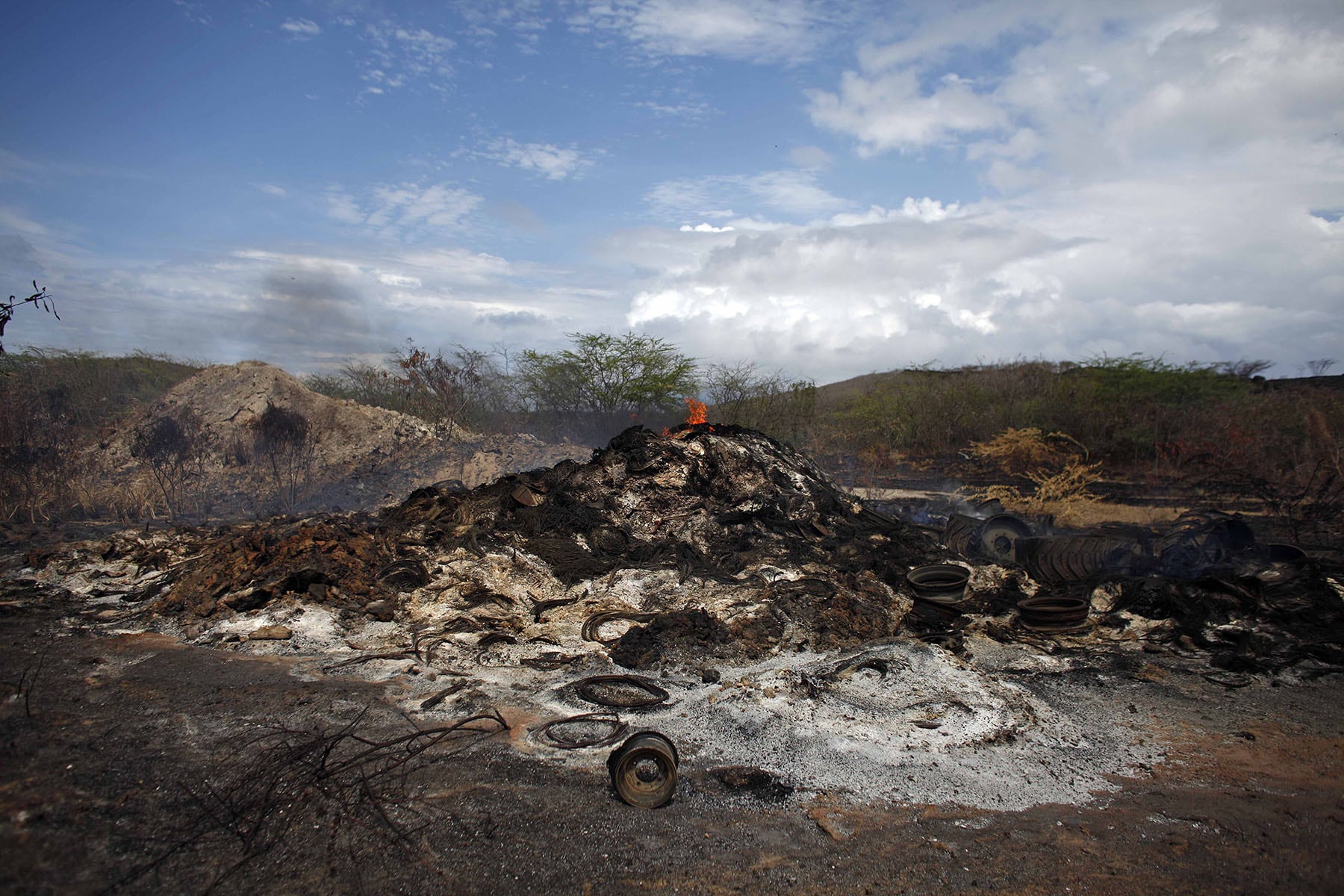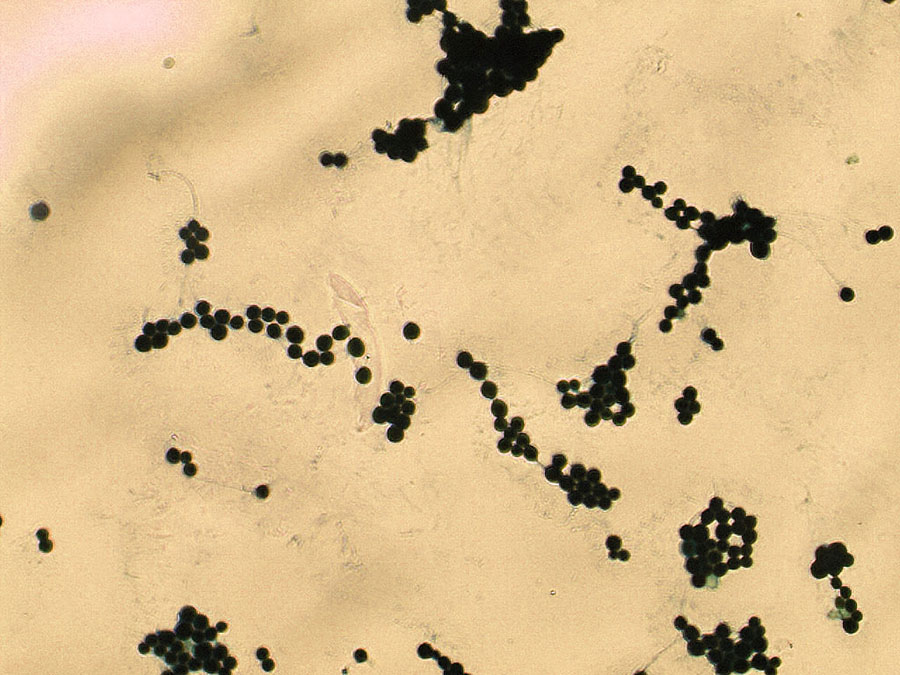The emerging field of disaster microbiology builds on the fact that human health is inherently interconnected with animals, plants, microbes, and the environment—for better or worse.
Houston wasn’t supposed to be this hot in June. Nevertheless, as the American Society for Microbiology convened its annual meeting at the George R. Brown Convention Center, a sprawling glass-and-white-aluminum complex on the edge of downtown, the city recorded its first 100 degree day—a whole month earlier than normal. This was the first of 45 days of triple-digit temperatures for Houston in 2023, only one day short of the all-time record of 46 consecutive days in 2011. This extreme heat event was a fitting backdrop for the society’s first session of a newly named but growing field: disaster microbiology, the science of anything-but-normal.
Self-proclaimed disaster microbiologists have spent their careers researching a diversity of catastrophes: record-breaking heat waves like the ones seen in Houston, the environmental legacy of decades of U.S. weapons testing on Vieques, one of the islands that make up Puerto Rico, and the creeping spread of drought to much of America’s heartland. But these scientists go beyond the visible impacts of disaster—the rows of shriveled crops or the shrapnel fragments left in sand. They take to the microscope to see how these events impact microbes, the tiny but mighty organisms that cycle nutrients through the ground and cause pandemics.
Disasters themselves are nothing new. However, a colloquium of 31 microbiologists first called for the creation of a disaster microbiology field in 2021 to respond to the accelerating rate of natural disasters due to climate change. When Daniel Smith, a postdoctoral fellow at Johns Hopkins, read their report, he responded with a paper that broadened its proposed definition to include anthropogenic disasters like oil spills and nuclear accidents. “Those are also disasters, and microbiology is involved. I think those are important aspects that would be overlooked otherwise,” he says.
“We could say ‘Oh a disaster should only be from this list.’ But right now, with this changing climate and changing world, I think we need to be looking into anything that is unusual,” says Lizbeth Dávila Santiago, an environmental microbiologist at the University of Puerto Rico at Arecibo, who was one of the presenters in Houston. She and Smith agree that now is the time to understand the microbiological impacts of disasters before they become more frequent in the coming decades.
Extreme heat and fungal pathogens
According to Smith’s definition, disaster microbiology is concerned with how a given disturbance can cause adaptations or spread in microbes—be they genetic mutations to the organism or their introduction into a new environment. Houston’s extreme heat events are one example of an environmental disturbance to be increasingly aware of, he says, as it may be both driving genetic changes to fungi that live in the environment as well as promoting their spread.
Most fungi, even pathogenic species, do not pose a threat of infection to humans, says Asiya Gusa, a professor at Duke University. “A large part of that is because human body temperature serves as a thermal barrier to infection,” she says. “Most environmental fungi cannot grow or proliferate at all at 98.6 degrees Fahrenheit [the approximate human body temperature].”
There is environmental evidence that fungi are already adapting to cross humans’ thermal defense barrier.
However, Gusa doesn’t see this summer’s extreme heat events as a good sign. “One of our worries is that as these temperatures increase outside, there’s a selective pressure for fungi to grow at higher temperatures, which could make them a bigger threat to us.”
In a recent project, Gusa’s team found that the pathogenic fungi Cryptococcus grown at 98.6°F exhibited an accumulation of mobile DNA elements called transposons. Transposons can move from place to place in the genome, changing a given region’s genetic sequence by pasting themselves where they please. “This could mean that fungi in the environment have a mechanism to react to higher temperatures and stress in general, stimulating further changes in the genome that could enhance their ability to cause disease,” says Gusa.
There is environmental evidence that fungi are already adapting to cross humans’ thermal defense barrier. Candida auris, a multidrug-resistant yeast that was first discovered in a 70-year-old Japanese woman’s infected ear in 2009, is thought to have transitioned from an environmental to pathogenic microbe in response to global warming. In 2022, there were more than 8,000 cases of Candida auris infection in the United States. “We’re seeing many more severe weather events, and we’re seeing an uptick of new, emerging fungal diseases,” Gusa said. “And so all of a sudden, we’re scrambling a bit to understand the implications. This is happening faster than we thought and climate change might be the cause.”

Interdisciplinary collaborations
Smith notes that disaster microbiology is inherently interdisciplinary, bringing in voices from social sciences, engineering, climatology, as well as microbiology—and follows a One Health perspective, which acknowledges and attempts to respond to the fact that human health is inherently interconnected with the health of animals and the environment.
Kathleen Treseder is a disaster microbiologist who embraces this approach, partnering with experts in climate modeling to examine how the Coccidioides pathogen could respond to regional climate changes. The Coccidioides fungus grows in desert soils throughout the Southwestern United States. In periods of drought, the fungus breaks apart into spores that become airborne due to high winds. The result in those who inhale the spores is Valley fever, which infects 20,000 Americans a year, 40 percent of whom are hospitalized.
“For collaborations like this, it’s really important to think about the end goal,” says Treseder, a professor at the University of California, Irvine, and an elected member of the Irvine city council. “In our case, we wanted to make sure that people are protected from Coccidioides causing an epidemic.”
“It’s really important for us to understand all the different ways that an ecosystem is resilient, and microbes are so important to that.”
When Treseder first began studying Coccidioides, the Centers for Disease Control’s existing endemicity map was primarily based on skin samples collected between 1945 and 1951. In addition, the data was mostly from Caucasian Navy personnel under the age of 21, while the primary risk groups for Valley fever in 2023 are people over sixty and people who are Black or Filipino, though it’s not clear why.
Treseder’s team contacted health agencies in every county where Valley fever was a reportable disease for more recent data, then overlaid 15 years of disease data with climate data to find that incidence was higher in areas with hotter temperatures and drier soils. From there, the team created a model to see what might happen to Coccidioides incidence as some states in the West become drier and hotter. Their final model predicts that changing environmental conditions in the Dakotas, Idaho, Wyoming, and Montana will allow Coccidioides to make a new home in these locales, increasing national Valley fever cases by 50 percent and doubling the area of the country where Coccidioides can be found by the end of the century.
Treseder notes that the team’s predictions of spread into the mountain states come at a time when many states are not prepared for Coccidioides outbreaks. It’s already common for people to be misdiagnosed with pneumonia initially, which delays the administration of antifungal treatment. In addition, data on the disease’s national prevalence can be sparse, as 24 states, including the southwestern state of Texas, do not require clinical cases to be reported to the health department.
“We wanted to make sure that the results we get are translated into information that people can use,” Treseder says. “It helps a lot to have some governmental connections so that if scientists find something really important, we know who to contact.” She notes that the U.S. Centers for Disease Control and Prevention (CDC) was responsive to the research team contacting them with their results, and since then the agency has noted on its website that climate change might expand the fungus’ geographic range. However, the organization has not explicitly changed their endemicity maps to account for climate projections.
Smith says the significance of Treseder’s research is that if disaster microbiology can predict major health concerns before they occur, as she has done, it could dramatically improve our response. “If we know Coccidioides is going to spread through half the United States [by area], dedicating more funding and energy to it would be beneficial,” he says.
Reasons to hope
Adding considerations for microbes into climate change projections seems like it is only lengthening the list of things to worry about. However, disaster microbiology also underscores that microbes have always been a major aspect of how life heals after disaster. “Ecology is all about being able to withstand change,” says Elias Dueker, a biologist at Bard College in Annandale-on-Hudson, New York. “It’s really important for us to understand all the different ways that an ecosystem is resilient, and microbes are so important to that.” Microbes adapt exponentially faster than humans or animals can thanks to their short generation times, and in some instances their resilience could also be a key to our own.
Take, for example, University of Puerto Rico at Arecibo Environmental Microbiologist Lizbeth Dávila Santiago’s research into the microbial recovery of Vieques, an island off the coast of Puerto Rico that was used by the U.S. Navy as a bombing range starting in the 1940s. After civilian and Vieques native David Sanes was killed by an off-target bomb in 1999, protests began that led to the Navy’s exit from the site in 2003. However, due to high levels of heavy metal contamination and potential unexploded ordnance, the Environmental Protection Agency named the island a Superfund site in 2004—designating the site as eligible for federal funding for the decades-long cleanup effort.
The microbes that remained contained genes that allowed them to break down some of the island’s pollutants.
As part of her master’s thesis, Dávila Santiago surveyed more than two decades of microbial samples collected from the Anones Lagoon in Vieques to document the area’s recovery. “This was the first time we applied bioinformatics and metagenomics to the microbial communities of Vieques across time,” she says. In the first year of samples, the team noted decreased microbial diversity compared to a control sample from a wildlife reserve, demonstrating the initial loss of environmental equilibrium. However, the microbes that remained contained genes that allowed them to break down some of the island’s pollutants, including heavy metals and explosives such as TNT and RDX.
Dávila Santiago notes that she was first attracted to the field because of its ability to transcend the boundaries of hard science alone. “The field actually tries to not just be about microbiology, but actually to touch upon the economic and societal parts of disaster,” she says. Knowing the history of what happened in Vieques, her team also gave careful consideration to naming the new bacterial family discovered in what remained. They started with “Bieke,” the indigenous name of the island before Spanish colonization. “People from Puerto Rico can understand what the genus name actually means,” she says. “And the species name, I think it explains the resilience of the microbial community there.” The full name, Biekeibacterium resiliens, describes a bacteria that is “trying to detoxify the island.”
This isn’t a one-off study. The more researchers take a microscope to disaster sites, the more they have been able to understand how microbes withstand what is thrown at them. Black fungi grow on the inside of the Chernobyl reactor, using melanin to survive excess levels of radiation. This same fungal melanin, when extracted, might protect astronauts from space radiation. In another instance, uranium-detoxifying bacteria first discovered in a hydrocarbon-contaminated ditch in Oklahoma was employed to clean up mine-contaminated groundwater in Colorado.
These are examples of what one might call ex calamitate provenit (“from calamity springs advantage”). Or, as Smith says, “How, out of a disaster, we discover a new microbe that can be used for benefit elsewhere.”














